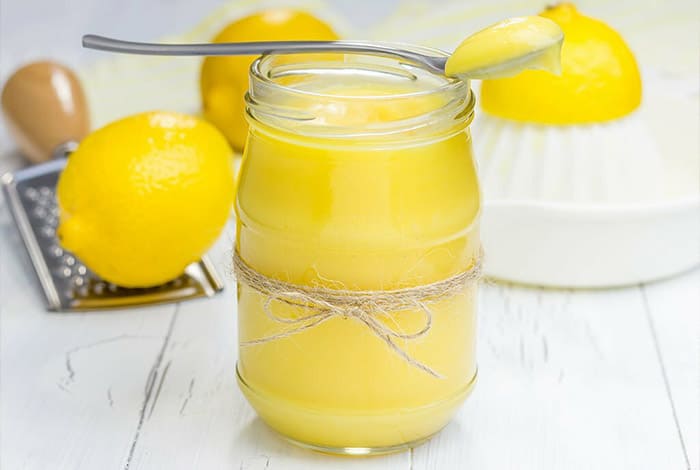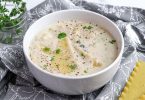Easy Lemon Curd: A Zesty Delight for All Seasons
Lemon curd, a delightful spread known for its bright, tangy flavor, has been gracing tables for centuries. Originating from England in the late 19th or early 20th century, it was traditionally served with bread or scones at afternoon tea as a spread or topping. Today, its popularity has spread worldwide, becoming a beloved ingredient in a myriad of desserts.
This citrus-based spread is celebrated for its versatility in the culinary world. It’s not just limited to being a spread for scones and toast; lemon curd serves as a vibrant filling for cakes, tarts, and pastries. It’s also used as a topping for yogurt, ice cream, and other desserts, adding a refreshing zest to every dish. The balance of sweetness and acidity in lemon curd makes it a unique component in both sweet and savory recipes, enhancing flavors and textures in a variety of dishes.
Ingredients and Tools
Essential Ingredients
Creating the perfect lemon curd requires a few key ingredients, each playing a crucial role in achieving that signature taste and texture:
- Fresh Lemons: The star of the show, providing the essential zesty flavor and natural acidity. The freshness of the lemons is paramount for a vibrant taste.
- Sugar: Balances the tartness of the lemons and adds sweetness, crucial for the curd’s palatable flavor.
- Eggs: They thicken the curd, giving it a rich, creamy texture. The quality of the eggs can significantly affect the final product.
- Butter: Adds smoothness and a luxurious mouthfeel, rounding out the flavors beautifully.
The quality and freshness of these ingredients are vital. Fresh, organic lemons and high-quality butter can make a noticeable difference in the taste and texture of the curd.
Learn more about the health benefits of lemons.
Required Kitchen Tools
To make lemon curd, you’ll need some basic kitchen tools:
- Zester or Grater: For extracting the zest from the lemons without the bitter pith.
- Juicer: To efficiently extract the maximum amount of juice from the lemons.
- Double Boiler or Heatproof Bowl: Essential for gentle cooking of the curd to prevent it from curdling.
- Whisk: A crucial tool for continuously stirring the mixture, ensuring a smooth and even texture.
A few tips for the best results:
- Ensure all ingredients are at room temperature before starting.
- Constantly whisk the mixture to avoid it getting burnt or curdled.
- Use a thermometer to monitor the temperature, keeping it consistent for the perfect consistency.
Step-by-Step Recipe: Crafting Your Lemon Curd
Creating lemon curd is an art that combines simplicity with a touch of culinary finesse. Here’s a detailed guide to help even beginners craft this delightful spread.
Preparation Steps
1. Zest and Juice the Lemons
- Begin by thoroughly washing the lemons. Using your zester or grater, zest the lemons until you have about two tablespoons of zest. Be careful to avoid the white pith, as it’s bitter.
- Cut the lemons in half and juice them. You’ll need approximately half a cup of lemon juice. Strain the juice to remove any seeds or pulp.
2. Mixing the Ingredients
- In the top part of your double boiler (or a heatproof bowl), combine the lemon zest, freshly squeezed lemon juice, sugar, and eggs. Whisk them together until the mixture is well blended.
- Tip for beginners: Before you start, make sure all ingredients are at room temperature to ensure they blend smoothly.
3. Cooking the Mixture
- Place the top part of the double boiler (or bowl) over simmering water. The water should not touch the bottom of the top pan or bowl.
- Cook the mixture over medium-low heat, whisking constantly. This is crucial to prevent the eggs from scrambling.
- Beginner’s tip: Keep the heat low and be patient. Rushing this process can lead to a curdled texture.
4. Thickening the Curd
- Continue to cook and whisk. After about 10 to 15 minutes, the mixture will start to thicken. It should coat the back of a spoon and hold a line drawn through it with your finger.
- Tip: Use a thermometer to check the temperature. The curd is done when it reaches about 170°F (77°C).
5. Finishing Touches
- Once thickened, remove the bowl from heat. Stir in the butter until it’s completely melted and the curd is smooth.
- If you want an extra smooth curd, strain it through a fine-mesh sieve to remove any bits of zest or egg that may have curdled.
6. Cooling and Storing
- Let the curd cool to room temperature. Then, transfer it into a jar or container. Cover it with a lid or plastic wrap, ensuring the wrap touches the surface of the curd to prevent a skin from forming.
- Refrigerate the curd. It will continue to thicken as it cools.
Tips for Beginners
- Consistency is Key: Keep whisking continuously for a smooth texture.
- Temperature Control: Avoid high heat to prevent the eggs from curdling.
- Freshness Matters: Use the freshest ingredients for the best flavor.
- Patience Pays Off: Take your time, especially when cooking and thickening the curd.
Variations and Tips
Recipe Variations
Lemon curd is wonderfully adaptable, allowing for various ingredient substitutions and dietary adaptations:
- Dairy-Free Lemon Curd: Replace butter with a dairy-free alternative like coconut oil or a vegan butter substitute. This swap maintains the creamy texture while catering to dairy-free diets.
- Reduced Sugar Version: For those watching their sugar intake, reduce the amount of sugar or use a sugar substitute. Keep in mind that this might slightly alter the texture and taste.
- Lime or Orange Curd: Substitute lemon juice and zest with lime or orange for a different citrus twist. Lime curd offers a more tropical flavor, while orange curd is sweeter and milder.
- Egg-Free Lemon Curd: Use cornstarch or a similar thickening agent as an alternative to eggs. This version will be less rich but still delicious.
Expert Tips for Perfect Lemon Curd
Professional chefs often share these tips for enhancing the texture and flavor of lemon curd:
- Temperature Control: Cook the curd over a gentle heat to avoid overheating, which can cause the eggs to scramble.
- Strain for Smoothness: For an ultra-smooth curd, strain the mixture through a fine-mesh sieve to remove any lumps or cooked egg bits.
- Balance Acidity and Sweetness: Adjust the sugar and lemon juice ratios according to taste. The perfect curd should have a balance of tartness and sweetness.
- Use Fresh Ingredients: Freshly squeezed lemon juice and fresh zest make a significant difference in flavor compared to bottled juice or dried zest.
Common Mistakes and Solutions
Troubleshooting Common Issues
Even experienced cooks can face challenges when making lemon curd. Here are some common issues and their solutions:
- Curdling: If the curd starts to curdle (small egg lumps form), immediately remove it from heat and whisk vigorously. Strain the mixture to remove any scrambled eggs.
- Too Runny: If the curd isn’t thickening, continue cooking it over low heat. Ensure constant stirring. Remember, it will thicken more as it cools.
- Too Thick: If the curd is too thick, gently whisk in a small amount of lemon juice or water until the desired consistency is reached.
- Grainy Texture: A grainy texture usually results from overcooked eggs. To prevent this, cook the curd over low heat and avoid letting it boil.
Pairing and Serving Suggestions
Lemon curd’s vibrant flavor and silky texture make it a versatile component in various culinary creations. Here are some creative ways to incorporate it into your dishes:
- As a Cake Filling: Layer lemon curd between sponge cake layers for a tangy twist.
- Tartlets and Pies: Fill pre-baked tart shells or pie crusts with lemon curd for a simple yet elegant dessert.
- With Yogurt or Ice Cream: Swirl lemon curd into Greek yogurt or vanilla ice cream for a refreshing treat.
- Breakfast Delight: Spread it on toast, croissants, or scones for a zesty start to your day.
- Dessert Topping: Drizzle over pavlovas, meringues, or cheesecakes for added zest.
- Parfait Layers: Alternate layers of lemon curd with whipped cream and fresh berries in a glass for a visually appealing and delicious parfait.
Presentation Tips
- Garnish with lemon zest or thin lemon slices for an extra touch of elegance.
- Serve in clear glasses or jars to showcase the vibrant color of the curd.
- Use mint leaves or edible flowers for a fresh, decorative finish.
Discover more dessert pairing ideas.
Nutritional Information
While lemon curd is a treat, understanding its nutritional aspects is important for a balanced diet:
- Caloric Content: Lemon curd is high in calories due to sugar and butter. Moderation is key.
- Vitamin C: Thanks to the lemons, it’s a good source of Vitamin C, which is essential for immune health and skin vitality.
- Fat Content: The butter and eggs contribute to the fat content, providing a rich texture but also adding saturated fats.
- Dietary Considerations: For those with dietary restrictions, consider using alternatives like sugar substitutes or dairy-free butter.
Lemon curd can be part of a balanced diet when enjoyed in moderation. Its bright flavor adds a delightful twist to various dishes, making it a favorite in kitchens worldwide.
FAQs – Your Lemon Curd Queries Answered
Lemon curd, with its delightful taste and versatility, often brings up several questions. Here are answers to some of the most common queries:
- How Long Can Lemon Curd Last in the Fridge?
- Properly stored in an airtight container, homemade lemon curd can last for 1-2 weeks in the refrigerator.
- Can Lemon Curd Be Frozen?
- Yes, lemon curd can be frozen for up to 3-4 months. Thaw it in the refrigerator before use.
- Why Did My Lemon Curd Turn Out Runny?
- This usually happens if it hasn’t been cooked long enough. Remember, it thickens as it cools. If it’s still runny after cooling, you can reheat and cook it a bit longer.
- Is Lemon Curd Gluten-Free?
- Traditional lemon curd recipes are gluten-free as they don’t contain flour or wheat products. However, always check the labels of your ingredients to be sure.
- Can I Make Lemon Curd Without Eggs?
- Yes, there are egg-free versions using cornstarch or agar-agar as thickeners, though the texture and taste might slightly differ.
- Is Lemon Curd the Same as Lemon Jam?
- No, lemon curd is creamier and richer due to the presence of butter and eggs, whereas lemon jam is more of a fruit preserve.
- Can I Use Bottled Lemon Juice?
- Fresh lemon juice is preferred for its flavor, but bottled juice can be used in a pinch. The taste may not be as vibrant.
Conclusion – The Joy of Lemon Curd
In conclusion, lemon curd is a delightful addition to any baker’s repertoire. Its bright, tangy flavor and creamy texture make it a versatile ingredient that can enhance a wide range of dishes. From being a simple spread for your morning toast to a sophisticated filling for desserts, lemon curd brings a burst of citrusy joy to every bite.
Whether you’re a seasoned chef or a home cook, the process of making lemon curd is both enjoyable and rewarding. Remember the tips and tricks shared in this guide, and don’t hesitate to experiment with variations to suit your taste and dietary needs.
So, why not give this recipe a try? The experience of creating your own batch of lemon curd is not only fun but also opens up a world of delicious possibilities. Enjoy the journey of cooking and the delightful flavors it brings!

Homemade Lemon Curd Recipe
Ingredients
- 1 cup fresh lemon juice about 4-5 lemons
- 2 teaspoons lemon zest
- 1 cup sugar
- 8 tablespoons unsalted butter melted
- 5 large eggs
- A pinch of salt
Instructions
Prepare the Lemons:
- Wash the lemons thoroughly.
- Zest the lemons to get about 2 teaspoons of lemon zest.
- Juice the lemons to make 1 cup of lemon juice. Strain the juice to remove seeds and pulp.
Mix the Ingredients:
- In a medium-sized mixing bowl, whisk together the lemon juice, lemon zest, sugar, and melted butter.
- In a separate bowl, beat the eggs and then add them to the lemon mixture. Stir until everything is well combined.
Cook the Mixture:
- Pour the mixture into a saucepan and cook over low heat.
- Stir continuously with a whisk or a wooden spoon. It’s important to keep the heat low and stir constantly to prevent the eggs from curdling.
Thicken the Curd:
- Continue to cook the mixture until it thickens enough to coat the back of a spoon, which usually takes about 10-15 minutes.
- The curd will thicken further as it cools, so don’t worry if it seems slightly runny in the saucepan.
Strain and Cool:
- Once the curd has thickened, remove it from heat.
- Strain it through a fine-mesh sieve into a bowl or jar to remove any lumps and the zest.
- Let the curd cool to room temperature.
Store:
- Transfer the cooled curd to airtight containers or jars.
- Refrigerate for up to 2 weeks.
Notes
Serving Suggestions:
- Spread on toast, scones, or muffins.
- Use as a filling for cakes, cupcakes, or tartlets.
- Dollop onto Greek yogurt or mix into whipped cream for a tangy dessert topping.








Leave a Comment